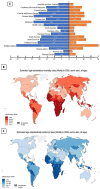The Catastrophic HPV/HIV Dual Viral Oncogenomics in Concert with Dysregulated Alternative Splicing in Cervical Cancer
- PMID: 34576278
- PMCID: PMC8472041
- DOI: 10.3390/ijms221810115
The Catastrophic HPV/HIV Dual Viral Oncogenomics in Concert with Dysregulated Alternative Splicing in Cervical Cancer
Abstract
Cervical cancer is a public health problem and has devastating effects in low-to-middle-income countries (LTMICs) such as the sub-Saharan African (SSA) countries. Infection by the human papillomavirus (HPV) is the main cause of cervical cancer. HIV positive women have higher HPV prevalence and cervical cancer incidence than their HIV negative counterparts do. Concurrent HPV/HIV infection is catastrophic, particularly to African women due to the high prevalence of HIV infections. Although various studies show a relationship between HPV, HIV and cervical cancer, there is still a gap in the knowledge concerning the precise nature of this tripartite association. Firstly, most studies show the relationship between HPV and cervical cancer at genomic and epigenetic levels, while the transcriptomic landscape of this relationship remains to be elucidated. Even though many studies have shown HPV/HIV dual viral pathogenesis, the dual molecular oncoviral effects on the development of cervical cancer remains largely uncertain. Furthermore, the effect of highly active antiretroviral therapy (HAART) on the cellular splicing machinery is unclear. Emerging evidence indicates the vital role played by host splicing events in both HPV and HIV infection in the development and progression to cervical cancer. Therefore, decoding the transcriptome landscape of this tripartite relationship holds promising therapeutic potential. This review will focus on the link between cellular splicing machinery, HPV, HIV infection and the aberrant alternative splicing events that take place in HIV/HPV-associated cervical cancer. Finally, we will investigate how these aberrant splicing events can be targeted for the development of new therapeutic strategies against HPV/HIV-associated cervical cancer.
Keywords: alternative splicing; cervical cancer; highly active antiretroviral therapy (HAART); human immunodeficiency virus (HIV); human papillomavirus (HPV); oncovirus.
Conflict of interest statement
The authors declare no conflict of interest.
Figures






Similar articles
-
Cervical human papillomavirus infection and cervical intraepithelial neoplasia in women positive for human immunodeficiency virus in the era of highly active antiretroviral therapy.Curr Opin Oncol. 2003 Sep;15(5):382-8. doi: 10.1097/00001622-200309000-00007. Curr Opin Oncol. 2003. PMID: 12960521 Review.
-
Prevalence of and risks for cervical human papillomavirus infection and squamous intraepithelial lesions in adolescent girls: impact of infection with human immunodeficiency virus.Arch Pediatr Adolesc Med. 2000 Feb;154(2):127-34. doi: 10.1001/archpedi.154.2.127. Arch Pediatr Adolesc Med. 2000. PMID: 10665598
-
HIV, human papillomavirus, and cervical neoplasia and cancer in the era of highly active antiretroviral therapy.Eur J Cancer Prev. 2008 Nov;17(6):545-54. doi: 10.1097/CEJ.0b013e3282f75ea1. Eur J Cancer Prev. 2008. PMID: 18941376 Review.
-
Evaluation of HIV and highly active antiretroviral therapy on the natural history of human papillomavirus infection and cervical cytopathologic findings in HIV-positive and high-risk HIV-negative women.J Infect Dis. 2013 Aug 1;208(3):454-62. doi: 10.1093/infdis/jit181. Epub 2013 Apr 26. J Infect Dis. 2013. PMID: 23624362
-
Cervical abnormalities, human papillomavirus, and human immunodeficiency virus infections in women in Malawi.J Infect Dis. 1996 Mar;173(3):714-7. doi: 10.1093/infdis/173.3.714. J Infect Dis. 1996. PMID: 8627037
Cited by
-
Clinicopathological features of papillary thyroid carcinoma in HIV-infected patients.Front Oncol. 2023 May 5;13:1071923. doi: 10.3389/fonc.2023.1071923. eCollection 2023. Front Oncol. 2023. PMID: 37213296 Free PMC article.
-
Everolimus (RAD001) combined with programmed death-1 (PD-1) blockade enhances radiosensitivity of cervical cancer and programmed death-ligand 1 (PD-L1) expression by blocking the phosphoinositide 3-kinase (PI3K)/protein kinase B (AKT)/mammalian target of rapamycin (mTOR)/S6 kinase 1 (S6K1) pathway.Bioengineered. 2022 Apr;13(4):11240-11257. doi: 10.1080/21655979.2022.2064205. Bioengineered. 2022. PMID: 35485300 Free PMC article.
-
Implications of viral infections and oncogenesis in uterine cervical carcinoma etiology and pathogenesis.Front Microbiol. 2023 May 24;14:1194431. doi: 10.3389/fmicb.2023.1194431. eCollection 2023. Front Microbiol. 2023. PMID: 37293236 Free PMC article. Review.
-
Entangled Connections: HIV and HPV Interplay in Cervical Cancer-A Comprehensive Review.Int J Mol Sci. 2024 Sep 26;25(19):10358. doi: 10.3390/ijms251910358. Int J Mol Sci. 2024. PMID: 39408687 Free PMC article. Review.
-
Prevalence of high-risk human papillomavirus genotypes in outpatient Malian women living with HIV: a pilot study.BMC Infect Dis. 2024 May 22;24(1):513. doi: 10.1186/s12879-024-09412-y. BMC Infect Dis. 2024. PMID: 38778266 Free PMC article.
References
Publication types
MeSH terms
Substances
LinkOut - more resources
Full Text Sources
Medical
Research Materials
Miscellaneous

